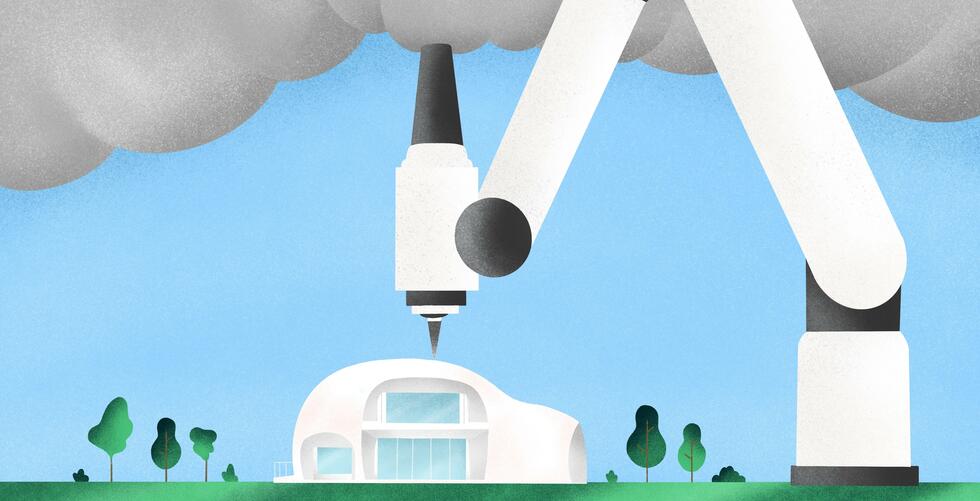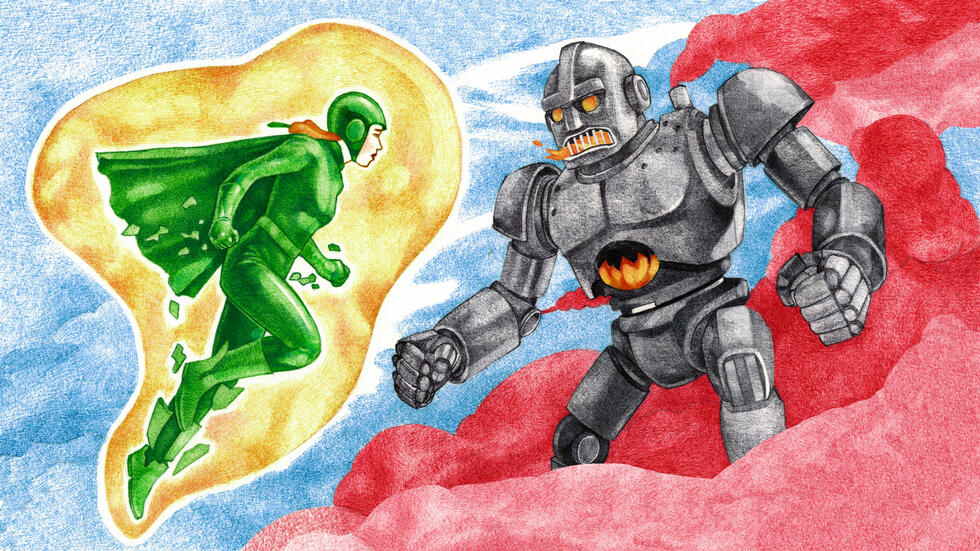A ropeway to boost Biel’s urban development
In the mid-20th century, Biel bore the title “city of the future”. However, since the decline of the watchmaking industry, the city has lost much of its glamour and now regularly makes negative headlines. Two citizens of Biel want to change this. Their vision: An urban ropeway to trigger the transformation to a green, social, and smart city. So that by 2030, Biel can once again live up to its former title.

Biel is a unique melting pot. Its bilingualism unites French savoir-vivre with Swiss-German down-to-earthness.
Biel is a unique melting pot. Its bilingualism unites French savoir-vivre with Swiss-German down-to-earthness. The self-perception of Biel’s citizens is determined by the conviction that they are different from the rest of Switzerland. What are the roots of this distinct local patriotism?
It may be due to the bilingualism, the diverse cultural mix, or the creative spirit that pulsates through the city. But it could also be the result of how brilliantly Biel presented itself at the last national exhibition, Expo.02, of its unique economic history as the watchmaking capital of the world, or of its leading position in Switzerland as a hub for high-tech companies.
From the outside, however, Biel is usually viewed quite differently. As the city with the highest proportion of welfare recipients in Switzerland – “Switzerland’s poorhouse”, as one freesheet headlined a few years ago. The dingy image clings stubbornly to the city and teints the way it is perceived by the rest of Switzerland.
And indeed, not everything is rosy, as a walk through Biel’s city center proves: Many of the facades are in disrepair, the streets are congested, and green areas are few and far between. What is needed is a vision. We have one, and in a quite un-Swiss manner, we say: Think big! But let’s start at the beginning.
A summer evening’s eureka moment
It was on a warm summer evening on the shores of Lake Biel, when we were having one of our serious reflections on the future of Biel – the city we grew up in, the city we love. How could Biel make the turnaround, leave negative headlines behind, and regain its cool and appeal?
One of us had already accomplished an initial step. Thanks to Reto’s initiative, the dormant city center has gained a new lease of life. “First Friday” has become one of the most important cultural fixtures in Biel. The monthly event showcases local art, culture, and small businesses and has revitalized an entire district. A resounding success – but we want more: Biel has to become the city of the future it once was.
“How about we bring a ropeway to Biel?”, I asked Reto on that summer evening as the sun was setting. An unwonted image, because in Switzerland, we mainly associate cable cars with winter sports in the mountains. But why not? An urban ropeway would transport people through the air, connect the city, and allow new life to emerge below.
That’s how our vision was born. A vision that could become a reality by as early as 2030. After all, countless urban ropeways are already in operation around the world, and their feasibility has long been proven in Europe as well.
That’s how our vision was born. A vision that could become a reality by as early as 2030. After all, countless urban ropeways are already in operation around the world, and their feasibility has long been proven in Europe as well. Paris recently started the construction of a ropeway. The cable cars are made in Switzerland – as are those for many urban ropeways in South America and Asia.
Nevertheless, no major urban ropeway project has ever been implemented in a Swiss city. All the more reason for us to wonder: Why not?
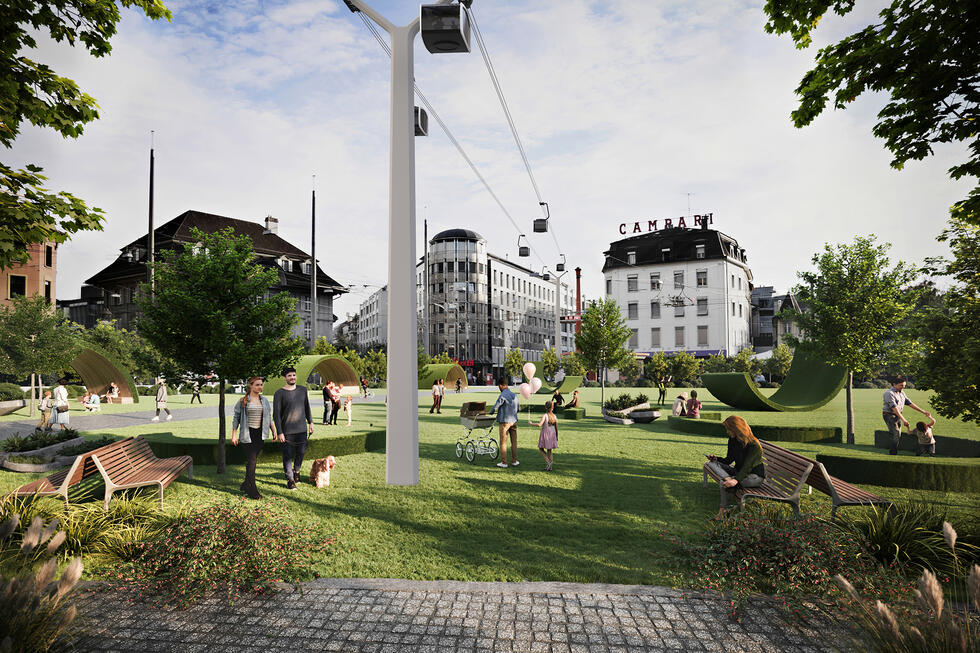

The transformative potential of ropeways
Stefan first touched on the subject of urban ropeways through CWA, the Olten-based cable car manufacturer, and he has been fascinated by the topic ever since. Having portrayed districts and cities as diverse as Sarajevo, Johannesburg, and Detroit, Stefan is familiar with the problems of mobility and fragmentation and he has thus gained an edge in knowledge and an affinity for urban life. This is why we were able to rapidly establish contact with the world market leader Garaventa/Doppelmayr, which should prove profitable for the realization of this vision.
"Moving through the air is more ecological than driving a car. In addition, it frees up the roads, and the infrastructure is comparatively inexpensive – much more cost-effective than laying tracks for streetcars or building in the underground."
We were also met with great interest in the city of Biel. Talks with some the city’s innovative minds and decision-makers proved: The idea makes sense. Marcel Aeschlimann, Managing Partner of the Biel-based innovation factory Creaholic, puts it in a nutshell: "Moving through the air is more ecological than driving a car. In addition, it frees up the roads, and the infrastructure is comparatively inexpensive – much more cost-effective than laying tracks for streetcars or building in the underground."
Christine Maier, the Director of the Biel Transport Authority, has a very similar view: “Since ground space is limited, taking to the air is a natural choice. I also love the fact that the view from above would offer passengers an entirely new perspective of our city.”
The new perspectives offered by urban ropeways are indeed intriguing for a city intent on mastering the challenges of the future. Ropeways relieve pressure from the streets and create space for new things. Biel would gain space to develop in a new way – also upwards: “The city becomes three-dimensional”, said one decision-maker from Biel to whom we presented our vision.
In order to focus the transformative power of an urban ropeway, we devised a tiered framework. On the basis of the three spheres “social city”, “green city”, and “smart city”, we illustrate where the challenges of the city of the future lie, and propose concrete measures in relation to the city of Biel – including ideas for landscaping and renaturation, a car-free city center, the promotion of non-motorized mobility, new cultural platforms and social meeting spaces, as well as digital tools such as a city app for smartphones.
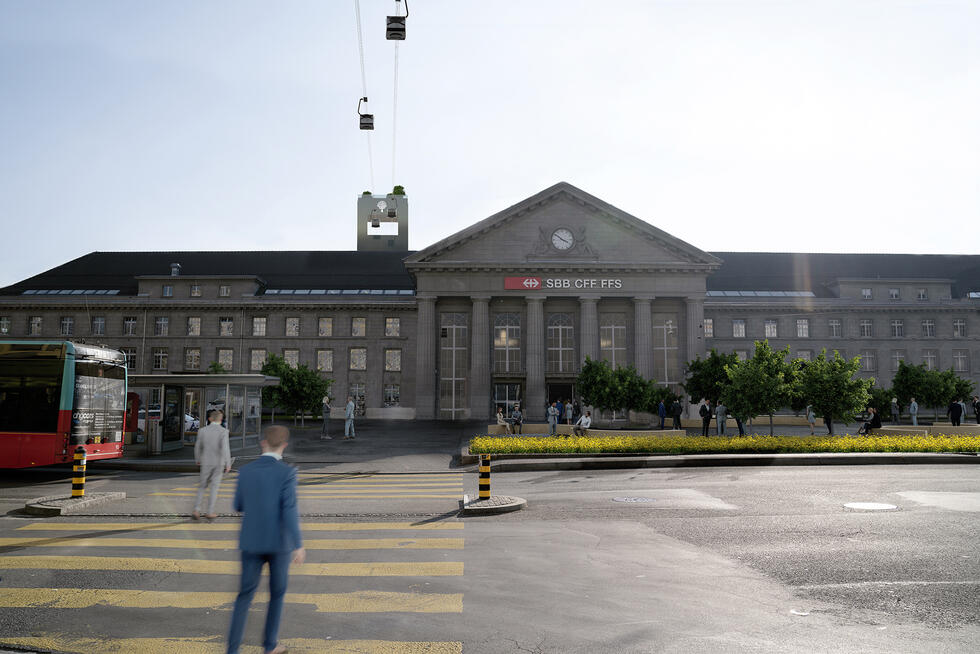

Green city – urban development close to nature
So we were sitting by the lake talking about our vision, entranced by the calming atmosphere of the natural surroundings. And we wondered: Why is it that Biel only really has green areas along the lakeshore? The closer you get to the city center, the less remains of the natural environment. The squares are covered with concrete, there are no green areas, and traffic dominates. Even the many waterways are barely noticeable. Only the Schüssinsel illustrates what would be possible.
Concrete surfaces heat up the city during the summer and should make way for natural cool spots with shady green spaces. And like any city, Biel needs to reduce its emissions and become climate neutral. The urban fabric must lose the gray and become greener. It is time to take action and prioritize the climate.
We are convinced that Biel offers perfect conditions to carry the surrounding natural environment into the interior of the city and bring nature closer to its inhabitants. This would also benefit the city’s climate: Concrete surfaces heat up the city during the summer and should make way for natural cool spots with shady green spaces. And like any city, Biel needs to reduce its emissions and become climate neutral. The urban fabric must lose the gray and become greener. It is time to take action and prioritize the climate.
The ropeway is not simply an alternative, it is a solution to achieve climate-neutrality. The cable car makes it possible to banish motorized traffic from the city, to efficiently link the hubs of urban traffic with zero carbon emissions, and to create new space for renaturalization and biodiversity. If Biel pulls off this transformation, it would earn recognition throughout Switzerland, perhaps even worldwide.
The ropeway would help Biel develop into a city by the lake. The idea: On the former site of the national exhibition – between Nidau Castle, the Dispo, the Lago Lodge, and the lake – a park will be created that will be accessible by ropeway. On the one hand, it would serve as a local recreation zone, and on the other hand, it would be a new venue for cultural events. Pavilions of various sizes that can be used all year round would offer the possibility of outdoor events in summer and indoor events in winter.
Concerts, seminars, exhibitions – the lakeside would become a new meeting point for everyone who wants to enjoy nature or participate in cultural activities. In this way, an area that has fallen into oblivion and that we consider to be one of the most beautiful locations in Switzerland would finally be given the revaluation it deserves.
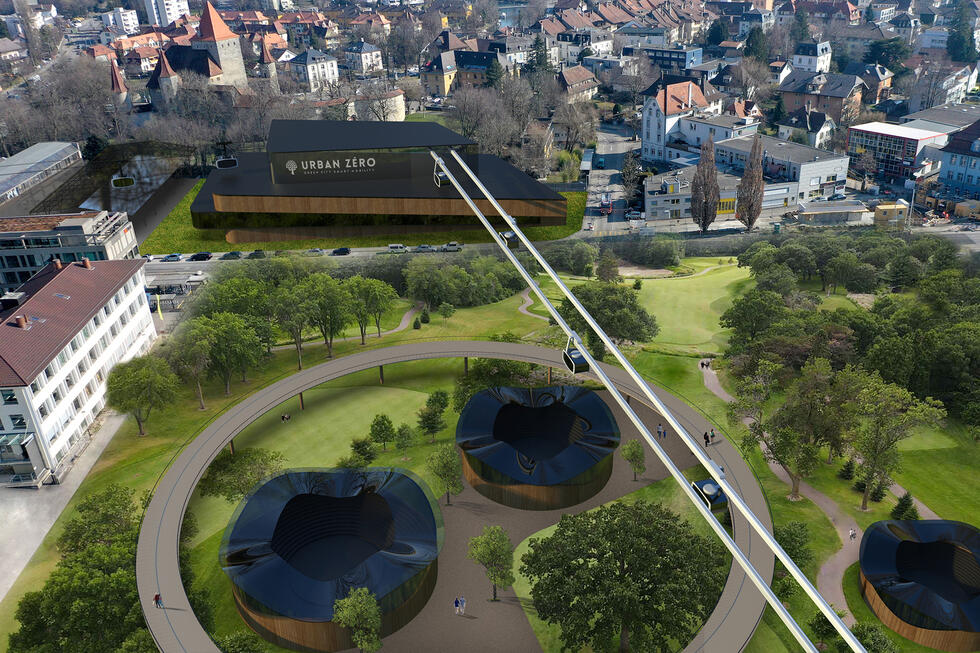

Social city – harnessing the cultural potential
In the meantime, the sun had set and our conversation turned to the previous “First Friday”. Once again, Biel's potential as a cultural hotspot had become evident. People exhibited, performed, and made music. People of all stripes came together and the entire local trade was represented – from Biel’s chocolatier and beer brewers all the way through to goldsmiths and tattooists. A success that should not be limited to the first Friday of the month and to the microcosm of the city center. The whole of Biel should awaken to new life.
Biel is known for its multicultural population, but also for its socio-political difficulties. In order to turn challenges into opportunities and a weakness into a strength, the different cultures must come together. To achieve this, neighborhoods must be systematically upgraded and interlinked with appealing mobility services. So that people can explore, get to know each other, and learn and benefit from each other.
The ropeway could foster this development. The stations could serve as social hubs with markets, art installations, cultural performances, and culinary amenities. In this way, Biel’s dormant potential could be unlocked, not only on the first Friday of the month, during festivals and celebrations in the city center, but also in everyday life, and everywhere in the city.
A crucial keyword is inclusion. Everyone must be enabled to participate – all cultures and all generations. Barriers for people affected by mental and physical impairments must also be reduced even further. This calls for interactive processes and easily accessible public transportation. If the city grows together, it could realize its potential and become Switzerland’s model city for social development.
Smart city – connecting the community
The bottle of wine was almost empty, and we wondered if anything was still going on in our city this summer evening. What we could really have used now was a city app that could answer this question at the tap of a screen. Such a solution would allow the community – the “users” of our city – to easily explore all the cultural events in their vicinity. Ideally, the app would also be connected to public transport. In this way, we could have conveniently purchased a ticket for the ropeway and venture into the city center that evening.
Such digital services are an integral part of the quality of life in a modern city. Today, location marketing also encompasses technology. Young people want to live in a networked city. This includes attractive, public coworking spaces. After all, digital nomads work in the city of their choice – and their decision is in no small part swayed by the technological conditions.
We should seize the opportunities afforded to a smart city: A holistic package in an app that connects the community,
Consequently, there is no alternative to digitalization. We should seize the opportunities afforded to a smart city: A holistic package in an app that connects the community, intelligent security solutions, and a high level of connectivity throughout the entire urban area. The result would be an interactive network of relationships between citizens, the city administration, businesses, and policymakers.
A city app opens up the possibility of discovering everything the city has to offer from the smartphone. Be it travelling by ropeway, booking tickets for a concert, applying for a parking permit, reserving a coworking space, or learning about the city’s cultural life. The ropeway is emblematic of this networking and the connections it creates. At each station, there would be alternative mobility options – for example bicycles, e-scooters, and electric cars – that could be booked using the city app.


What makes Biel suitable
It was growing late, and we decided to share our vision with the world. During one evening, we discussed extensively why exactly Biel would be suitable to take this step into the future. And there was no lack of supporting arguments:
- The congested city center that needs to be freed from traffic to make room for new development.
- The gap between the lake and the city, between nature and concrete, which could be bridged by new connections.
- The cultural potential that slumbers in studios, cellars, and training rooms all around the city, just waiting to gain public visibility.
- The many cultures and languages, which are a matter of course in Biel, but which live separately because of the lack of places where people can get together.
- The economic expertise of the watchmaking city, home to numerous high-tech companies and the newly established Innovation Park.
The citizens of Biel would be the main beneficiaries of this transformation: Their housing situation would improve, their mobility options would become more diverse, their neighborhoods would be revitalized, and the city center would become an attractive, green area for people to encounter each other. In short: Biel would gain in quality of life.
But the many commuters would also feel a distinctive change. Biel-Bözingen is currently home to some 10,000 workplaces. Thanks to the ropeway, commuters could conveniently travel between the lake, the train station, the city center, and the industrial zone. And so would tourists: The watchmaking capital would once again become a center of attraction, in particular for guests from Asia. Many of the world’s most prestigious watch brands, gathered in one place – easily accessible in just a few minutes by cable car.
We are convinced: If this vision is realized, Biel will flourish. Once again, the tremendous verve of the bilingual city would be demonstrated, a city that never allows itself to be beaten down, but reinvents itself again and again – as a model for multilingual Switzerland, as a melting pot for art, culture, and modern ways of living and working.
It’s all there, we just have to crack open the treasure chest and unveil the contents. Then, Biel will once again become the city of the future that it once was. A vibrant hub for everyone who is seeking to live and work in a modern, livable, and attractive environment.




















































































